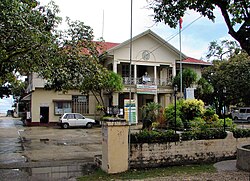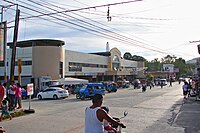Jagna, officially the Municipality of Jagna (Cebuano: Munisipalidad sa Jagna; Tagalog: Bayan ng Jagna), is a 3rd class municipality in the province of Bohol, Philippines. According to the 2020 census, it has a population of 35,832 people.[3]
Jagna | |
|---|---|
| Municipality of Jagna | |
 Jagna Town Hall | |
 Map of Bohol with Jagna highlighted | |
Location within the Philippines | |
| Coordinates: 9°39′N 124°22′E / 9.65°N 124.37°E | |
| Country | Philippines |
| Region | Central Visayas |
| Province | Bohol |
| District | 3rd district |
| Founded | 29 September 1631 |
| Barangays | 33 (see Barangays) |
| Government | |
| • Type | Sangguniang Bayan |
| • Mayor | Joseph A. Rañola |
| • Vice Mayor | Teofisto P. Pagar Jr. |
| • Representative | Kristine Alexie B. Tutor |
| • Municipal Council | Members |
| • Electorate | 21,499 voters (2022) |
| Area | |
| • Total | 168.49 km2 (65.05 sq mi) |
| Elevation | 106 m (348 ft) |
| Highest elevation | 641 m (2,103 ft) |
| Lowest elevation | 0 m (0 ft) |
| Population (2020 census)[3] | |
| • Total | 35,832 |
| • Density | 210/km2 (550/sq mi) |
| • Households | 8,381 |
| Economy | |
| • Income class | 3rd municipal income class |
| • Poverty incidence | 37.56 |
| • Revenue | ₱ 160.9 million (2020) |
| • Assets | ₱ 307.3 million (2020) |
| • Expenditure | ₱ 146.8 million (2020) |
| • Liabilities | ₱ 82.64 million (2020) |
| Service provider | |
| • Electricity | Bohol 2 Electric Cooperative (BOHECO 2) |
| Time zone | UTC+8 (PST) |
| ZIP code | 6308 |
| PSGC | |
| IDD : area code | +63 (0)38 |
| Native languages | Boholano dialect Cebuano Tagalog |
The town celebrates St. Michael's festival on September 29.[5] Highlights are cultural activities such as parades and street dancing. The month of May is also of interest, especially to returning Jagna-born Filipinos from across the islands and abroad. Celebrations of barangay fiestas occur almost every day.
History
editOn January 24, 1744, an Italian Jesuit curate in-charge of the town parish was killed by a native insurgent known to be Francisco Dagohoy. This event signaled the beginning of the Dagohoy Rebellion – the longest uprising in Philippine history.
The Lonoy Massacre in 1901 was a bloody American surprise attack launched on Filipino insurgents – the latter being led by Captain Gregorio Caseñas[a] – which were killed over 400, in the Philippine–American War. It was fought in the mountain village of Lonoy, north of the town proper.
A major earthquake devastated the town in 1990. The local residents were evacuated to the nearby hills for a few days, as local authorities warned of a possible tsunami that might hit the coastal area. However, such event did not happen. Some damage occurred to the church bell tower by the earthquake but has been completely repaired.
Jagna has a new market; the last one burned down in 1998 and a temporary market was set up in the grass field across the church. The new market is in operation – built on the site of the previous one that burned down. A recreational plaza is recently in construction on the grass field that was once the temporary market area.
Geography
editJagna is located on the southern coast of Bohol. It is one of the commercial trading centers of the province with daily market and port operations. Of interest to visitors is the town church built during the Spanish era, with its ceiling frescoes and baroque architecture. A waterfall and a spring reservoir can be found on the highlands, accessible by road travel north. A marine sanctuary zone has been set up by the local government just off the shore. A double reef is protected inside the sanctuary zone and marked off by buoys to restrict access from fishers.
Like Tagbilaran, Jagna is a port town. Ferries travel daily to and from other islands. Routes to Mindanao are available via Cagayan de Oro and Butuan. The island of Camiguin is visible from Jagna and a ferry operates from Jagna to the port of Balbagon in peak seasons. Jagna is 68 kilometres (42 mi) from Tagbilaran.
Barangays
edit
Jagna is politically subdivided into 33 barangays. Each barangay consists of puroks and some have sitios.
| PSGC | Barangay | Population | ±% p.a. | |||
|---|---|---|---|---|---|---|
| 2020[3] | 2010[6] | |||||
| 071225001 | Alejawan | 2.3% | 817 | 843 | −0.31% | |
| 071225002 | Balili | 3.4% | 1,233 | 1,263 | −0.24% | |
| 071225003 | Boctol | 3.1% | 1,103 | 1,023 | 0.76% | |
| 071225005 | Bunga Ilaya | 2.8% | 994 | 816 | 1.99% | |
| 071225006 | Bunga Mar | 4.1% | 1,459 | 1,385 | 0.52% | |
| 071225004 | Buyog | 1.0% | 344 | 386 | −1.15% | |
| 071225007 | Cabunga‑an | 3.8% | 1,344 | 1,179 | 1.32% | |
| 071225008 | Calabacita | 4.0% | 1,419 | 1,362 | 0.41% | |
| 071225009 | Cambugason | 3.0% | 1,071 | 993 | 0.76% | |
| 071225010 | Can‑ipol | 1.4% | 505 | 511 | −0.12% | |
| 071225014 | Can‑uba | 1.1% | 378 | 343 | 0.98% | |
| 071225015 | Can‑upao | 5.8% | 2,067 | 2,037 | 0.15% | |
| 071225011 | Canjulao | 8.0% | 2,870 | 2,752 | 0.42% | |
| 071225012 | Cantagay | 2.6% | 915 | 834 | 0.93% | |
| 071225013 | Cantuyoc | 2.3% | 830 | 884 | −0.63% | |
| 071225016 | Faraon | 1.6% | 581 | 547 | 0.60% | |
| 071225017 | Ipil | 0.9% | 321 | 319 | 0.06% | |
| 071225018 | Kinagbaan | 1.3% | 466 | 436 | 0.67% | |
| 071225019 | Laca | 0.7% | 257 | 316 | −2.05% | |
| 071225020 | Larapan | 2.2% | 778 | 764 | 0.18% | |
| 071225021 | Lonoy | 3.6% | 1,286 | 1,259 | 0.21% | |
| 071225022 | Looc | 2.1% | 740 | 865 | −1.55% | |
| 071225023 | Malbog | 3.0% | 1,078 | 1,031 | 0.45% | |
| 071225024 | Mayana | 6.2% | 2,235 | 1,482 | 4.19% | |
| 071225025 | Naatang | 1.6% | 583 | 580 | 0.05% | |
| 071225026 | Nausok | 1.0% | 349 | 348 | 0.03% | |
| 071225027 | Odiong | 2.7% | 979 | 1,023 | −0.44% | |
| 071225028 | Pagina | 3.6% | 1,297 | 1,405 | −0.80% | |
| 071225029 | Pangdan | 3.3% | 1,177 | 1,197 | −0.17% | |
| 071225030 | Poblacion (Pondol) | 2.5% | 885 | 1,020 | −1.41% | |
| 071225031 | Tejero | 4.0% | 1,440 | 1,412 | 0.20% | |
| 071225032 | Tubod Mar | 1.5% | 538 | 516 | 0.42% | |
| 071225033 | Tubod Monte | 4.3% | 1,553 | 1,435 | 0.79% | |
| Total | 35,832 | 32,566 | 0.96% | |||
Climate
edit| Climate data for Jagna, Bohol | |||||||||||||
|---|---|---|---|---|---|---|---|---|---|---|---|---|---|
| Month | Jan | Feb | Mar | Apr | May | Jun | Jul | Aug | Sep | Oct | Nov | Dec | Year |
| Mean daily maximum °C (°F) | 28 (82) | 29 (84) | 30 (86) | 31 (88) | 31 (88) | 30 (86) | 30 (86) | 30 (86) | 30 (86) | 29 (84) | 29 (84) | 29 (84) | 30 (85) |
| Mean daily minimum °C (°F) | 23 (73) | 22 (72) | 23 (73) | 23 (73) | 24 (75) | 25 (77) | 24 (75) | 24 (75) | 24 (75) | 24 (75) | 23 (73) | 23 (73) | 24 (74) |
| Average precipitation mm (inches) | 102 (4.0) | 85 (3.3) | 91 (3.6) | 75 (3.0) | 110 (4.3) | 141 (5.6) | 121 (4.8) | 107 (4.2) | 111 (4.4) | 144 (5.7) | 169 (6.7) | 139 (5.5) | 1,395 (55.1) |
| Average rainy days | 18.6 | 14.8 | 16.5 | 16.7 | 23.9 | 26.4 | 25.6 | 24.1 | 24.4 | 26.3 | 23.7 | 20.5 | 261.5 |
| Source: Meteoblue[7] | |||||||||||||
Government
editThe municipality is governed by the Local Government Unit (LGU) of Jagna, which is headed by the Municipal Mayor.[8]
| Year | Municipal Mayor |
|---|---|
| 2019–present | Joseph A. Rañola |
| 2010–2019 | Atty. Fortunato A. Abrenilla |
| 2001-2010 | Exuperio C. Lloren |
| 1995-2001 | Marciana O. Tsurumi |
| 1988-1995 | Atty. Alexander C. Villacastin |
| 1986-1988 | Cesar M. Cagulada |
| 1980-1986 | Atty. Alexander C. Villacastin |
| 1972-1980 | Atty. H. Domingo Bagaipo |
| 1968-1971 | Atty. Alexander C. VIllacastin |
| Nov. 1967 - Dec. 1967 | Glicerio Madrazo |
| 1965 - Aug. 1967 | Agripino Jamisola |
| 1955-1965 | Teodoro B. Galagar |
| 1946-1955 | Antonio Galope |
| 1941-1946 | Ubaldo Yap |
| 1931-1940 | Simplicio Cagampang |
| 1922-1931 | Juan Virtudes |
| 1916-1922 | Agustin Abrenilla |
| 1912-1916 | Catalino Caseñas |
| 1906-1912 | Agustin Abrenilla |
| 1902-1906 | Quintin Abrenilla |
| 1886-1898 | Severo Salas |
| 1882-1884 | Cruz Abrenilla |
Demographics
edit| Year | Pop. | ±% p.a. |
|---|---|---|
| 1903 | 4,331 | — |
| 1918 | 6,643 | +2.89% |
| 1939 | 12,384 | +3.01% |
| 1948 | 15,804 | +2.75% |
| 1960 | 12,177 | −2.15% |
| 1970 | 14,338 | +1.65% |
| 1975 | 15,903 | +2.10% |
| 1980 | 16,769 | +1.07% |
| 1990 | 21,135 | +2.34% |
| 1995 | 23,927 | +2.35% |
| 2000 | 26,826 | +2.48% |
| 2007 | 27,852 | +0.52% |
| 2010 | 32,566 | +5.86% |
| 2015 | 33,892 | +0.76% |
| 2020 | 35,832 | +1.10% |
| Source: Philippine Statistics Authority[9][6][10][11] | ||
Economy
editPoverty incidence of Jagna
10 20 30 40 2006 34.20 2009 36.43 2012 19.63 2015 23.32 2018 17.90 2021 37.56 Source: Philippine Statistics Authority[12][13][14][15][16][17][18][19] |
Education
editJagna as a key center for learning, the municipality boasts a cluster of respected educational institutions. It hosts many notable educational institutions in the southern part of Bohol including:
- Bohol Institute of Technology
- Calabacita National High School
- Central Visayan Institute Foundation
- Colegio de la Medalla Milagrosa
- Faraon National High School
- Jagna High School
- Lonoy Heroes Memorial High School
- San Miguel Academy
- Tubod Monte Integrated School
Gallery
edit- Pagina, Jagna
- Public market of Jagna
- Jagna Bay
- St. Michael the Archangel Parish, Jagna
Notes
edit- ^ who now features at the centre of the municipal seal








